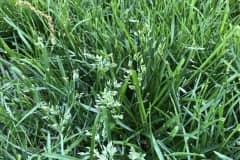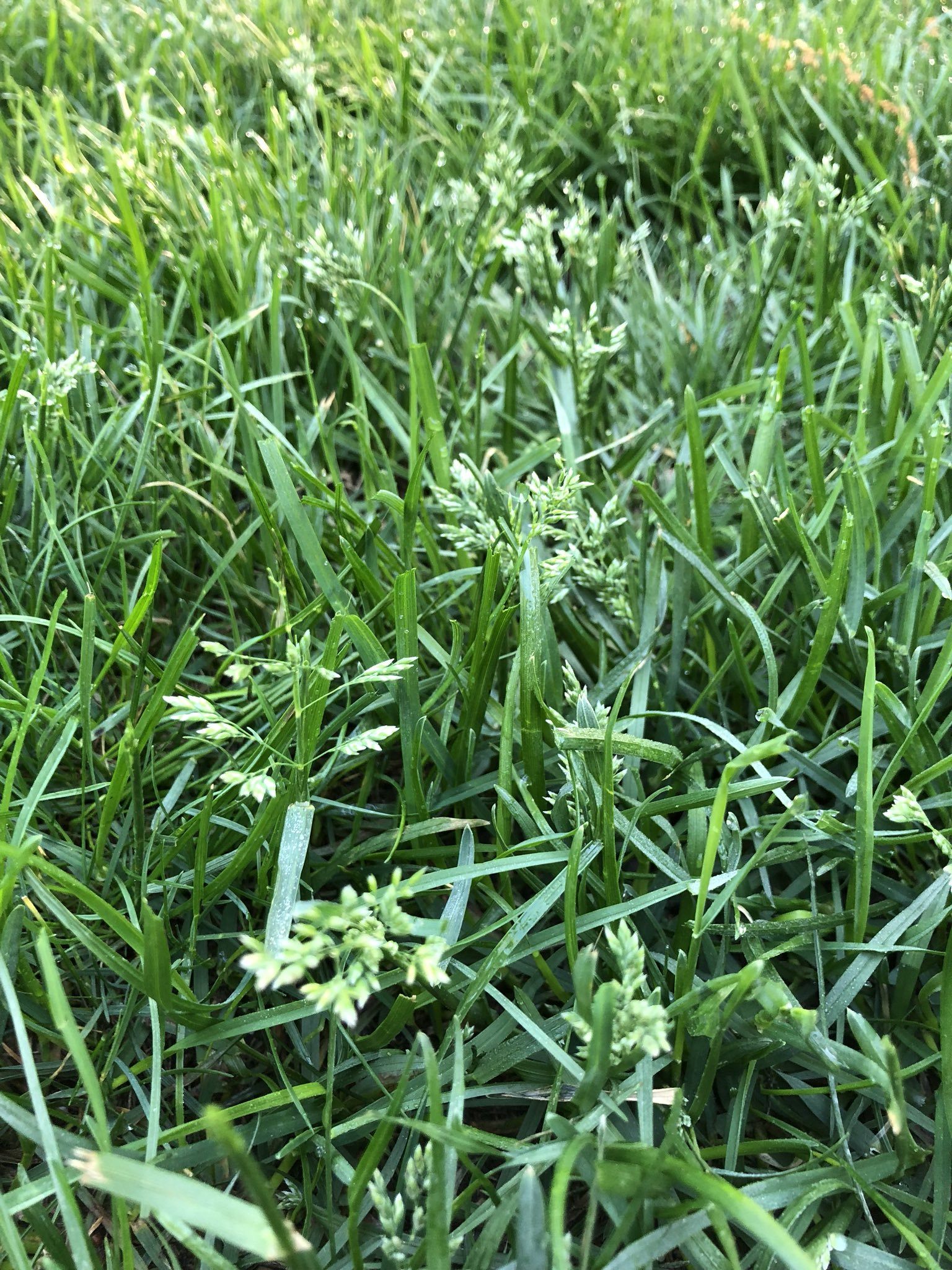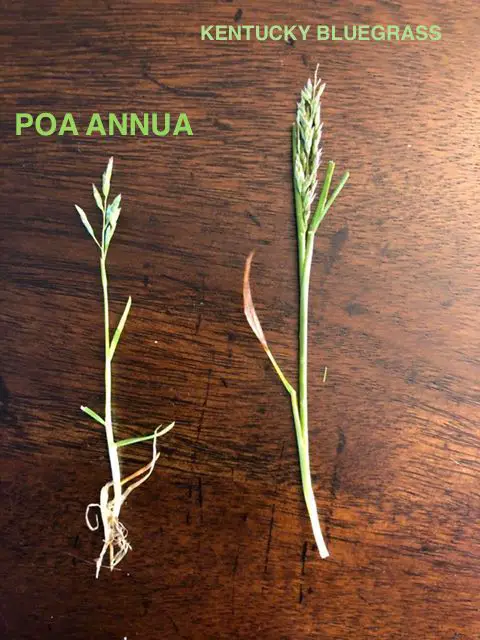LAWN PHIX PRO TIPS
The best way I have gotten rid of Poa Annua was by applying a pre-emergent at the end of summer. I’ve also had luck spraying Poa twice with Tenacity (Mesotrione), but the best post-emergent for annual bluegrass is Ethos 4SC (Ethofumesate). In 2022, I skipped fall overseeding and instead spot-sprayed the Poa in my yard with Ethos 4SC, and then applied Pendulum (Pendimethalin) at 4 lbs. per 1,000 sq. ft. in the first week of September. My lawn was virtually Poa-free in 2023.
- Poa annua is a winter annual that germinates in the late summer/early fall once soil temperatures fall below 70 degrees. Seedlings mature in the fall, overwinter in a vegetative state, and flower and produce seed in late spring and early summer.
- Avoid Overwatering:
- Poa annua prefers shady and damp areas.
- Water deeply, but infrequently:
- It has shallow roots and may not be able to reach down to where the moisture is.
- Set Your Mower High (3-4″)
- Poa annua is short.
- Taller grass makes it harder for annual bluegrass to survive.
- Lawns with taller grass tend to have fewer Poa annua problems.
Table of Contents
Though a close relative of Kentucky bluegrass, poa annua is a common grassy weed with an annual life cycle. Although this plant usually dies off with the hot summer weather, Poa annua seeds are quite resilient and can remain dormant in the soil for years, making Poa annua control extremely difficult. To kill this annual bluegrass, you may need to take a combination of Poa annua control measures that we’ll outline here.
What Is Poa Annua?
Poa annua is an annual bluegrass that lawn growers widely disdain because of its unattractive yellowish-green appearance, weedy seed heads that tend to persist even with mowing short, and annual life cycle that leaves lawns looking patchy by late summer or early fall. Poa annua plants are cool-season grasses that can grow in poor conditions like compact soil. Unlike most lawn grasses, Poa annua annual bluegrass has a shallow root system and is a prolific seeder. Poa annua germinates in the early fall. It will grow happily along roadways, on golf courses, and even in the center of your lawn.
Poa Annua Identification
Poa annua annual bluegrass is light green in color with a slightly yellowish tint. Because of its lighter hue, it often stands out from other grass types. Poa annua annual bluegrass produces a tall tasseled seed stalk, one of its telltale identifying markers. Poa annua grass will produce this seed stalk even when mowed short, so it’s tough to control Poa annua with cultural methods. Since Poa annua grass plants die off with the heat of early summer, it will leave the lawn looking bare and patchy.
Beginning in late summer or early fall, Poa annua seeds will begin to germinate. Poa annua germination can occur through early fall. Its seedlings will continue to grow through the fall and flower by early spring. This grassy weed can usually be spotted in winter in clumps; it will stop growing during the coldest part of winter but doesn’t die. It will grow rapidly in spring along with many other grassy and broadleaf weeds.



Poa Annua vs. Kentucky Bluegrass
Poa annua and Kentucky bluegrass are close grass-type relatives, but Poa annua is an annual weed. Technically, Poa annua is an annual grass, but it is regarded as a grassy weed because of its undesirability as lawn grass. Poa annua has a lighter shade of green than Kentucky bluegrass and, as mentioned, develops a more shallow root system than its perennial relative.
It can be difficult to determine the difference between the two types of grass without a close examination. Poa annua annual bluegrass typically produces an appendage (ligule) at its leaf base. The appendage looks like a small piece of clear tape. Kentucky bluegrass does not produce this membrane or, when it does, it is very short. Many people don’t realize they have a Poa annua weed problem until the late summer when their lawn begins to look yellow and patchy, where the Poa annua grass has died.
How to Control Poa Annua
If you have annual bluegrass growing in your lawn, you’ll want to control even small patches. Otherwise, the patches will grow larger and larger during subsequent growing seasons. It is challenging to control Poa annua because of its hardy seeds that can lay dormant in the soil for years. Herbicides do not typically harm Poa annua seeds, which makes complete eradication of annual bluegrass in a single season nearly impossible. You can also mow your grass higher, which can deter annual bluegrass from thriving. This may seem counterintuitive, but mowing this short-growing annual bluegrass short doesn’t seem to phase it. However, allowing your existing lawn to grow taller has a way of smothering out the Poa annua.
How to Kill Poa Annua
You can kill Poa annua by applying a pre-emergent herbicide designed for grassy weeds like annual bluegrass before the first frost or sometime in early fall. A pre-emergent herbicide is the best method for controlling Poa annua. A post-emergent herbicide may help kill Poa annua, but it’s important to apply it before the weed spreads. Annual bluegrass can spread quickly and aggressively. If you find that your post-emergent herbicide treatment hasn’t worked, you may want to spot-treat with a nonselective herbicide; this will kill the weed, but it can also harm surrounding grass, so it’s crucial to apply it only to the Poa annua and not any other plants.
How to Prevent Poa Annua
Using a pre-emergent herbicide in late summer or early fall is a tried-and-true measure to effectively control Poa annua. Although pre-emergent herbicides may not kill Poa annua by the next growing season, they will help you reduce the plant’s spread. You can eradicate this pesky weed from your lawn with subsequent pre-emergent herbicide applications during subsequent fall seasons and post-emergent herbicide applications.
Also, in addition to pre-emergent herbicides, post-emergent herbicides, and the occasional non-selective herbicide spot treatment, you can reduce the risk of an annual bluegrass infestation by mowing your grass a bit higher, maintaining a healthy lawn and watering your lawn infrequently but deeply. A dense, healthy lawn is its own defense against lawn weeds like annual bluegrass. You can more easily prevent weeds when maintaining a dense, healthy lawn.
Poa Annua FAQs
Does Tenacity herbicide kill Poa annua?
Tenacity is an off-label Poa annua control measure. It will kill Poa annua weed without harming your existing lawn, but it isn’t labeled for killing Poa annua.
Is Poa annua hard to kill?
Poa annua is difficult to kill because its weed seeds are so hardy. Annual bluegrass seeds can lay dormant in the soil for years. Poa annua drops many seeds, which is why it’s such a prolific weed. Use a pre-emergent herbicide to prevent annual bluegrass seeds from growing into seedlings.
What herbicide will kill Poa annua?
Herbicides that contain atrazine will selectively kill Poa annua. Tenacity herbicide can also kill Poa annua. If you have a few annual bluegrass plants, you can use nonselective herbicides to spot treat, especially if you notice the plant growing in sidewalk cracks or near your driveway.
Should you pull Poa annua?
A Poa annua plant has shallow roots, so it’s easy to pull. The plant is an annual weed that won’t spread via its roots. However, pulling the plant will be ineffective if it has already dropped its seed. It’s best to pull Poe annua before it develops its seed stalks.
How do you kill Poa annua in your yard?
It’s best to use a combination of measures to kill Poa annua in your lawn and landscape. Remember to use cultural methods like creating a dense lawn and mowing your grass high. Apply pre-emergent herbicides in late summer and post-emergent herbicides in early spring.
When does Poa Annua germinate?
Poa annua germinates in the late summer and early fall when soil temperatures start to fall below 70 degrees.
How do I get rid of Poa Annua?
Since it’s a winter annual grass, the best way to control Poa annua is to apply a pre-emergent to your lawn in late summer or early fall, and again the following spring. This will help prevent the invasive weed from germinating.
To get rid of and control Poa annua once it’s already established in your lawn, a non-selective herbicide like glyphosate will do the trick. Tenacity Herbicide will damage P. annua, although this isn’t listed on the label of weed grasses it’ll kill.
What’s the difference between Poa Annua and Kentucky Bluegrass?
Poa annua and Kentucky bluegrass look very similar when the grasses begin to flower and seed. But while P. annua is an annual cool season plant, KBG a perennial. The seeds that shed from P. annua germinate in late summer or early fall, where the KBG seeds are sterile and do not germinate. And while Poa annua appears as a lighter shade of green, KBG is known for its deep, dark green that sometimes appears blue.
What is another name for Poa Annua?
Poa annua is also known as annual bluegrass, annual meadow grass, or just Poa.
What’s the difference between Pao Annua and Poa Trivialis?
There’s a lot in common between Poa annua (annual bluegrass) and Poa trivialis (rough bluegrass). Both plants exhibit clumping growth and a lighter shade of green, but the main difference between the two weeds is that P. annua is an annual grass, while Poa triv is perennial.
Poa annua also flowers and produces seeds in late summer, whereas Poa triv generally does not. P. annua germinates in the early fall — usually in September — and survives overwinter in a vegetative state, only to emerge and thrive in your lawn the following early spring.
Both of these grasses require cultural and chemical weed control practices to manage.
Does Tenacity Kill Poa Annua (Annual Bluegrass)?
The label of Tenacity reads that both bentgrass and Poa annua are “sensitive to Tenacity applications.” We tried two applications of Tenacity with a non-ionic surfactant on P. annua and saw the weed turn white, then brown, and ultimately die. But this isn’t a guarantee that it’ll kill P. annua or similar weed species or prevent its weed seeds from shedding and germinating.
Does Tenacity work as a Pre-emergent against Poa Annua (Annual Bluegrass)?
The label of Tenacity reads that when used as a pre-emergent against weed species like Poa annua, it acts as a suppressant. It’s always best to use Prodiamine on your lawn in the late summer, and again the following spring to help prevent the germination of P. annua. But using Tenacity (Mesotrione) at seeding is a good measure to help control Poa annua.

I live in Memphis (Germantown), TN. This year the Poa Annua in my front and rear yards is the worst-n-thickest EVER since I’ve lived here. It seems like someone may have used a push rollercaster during the night at some point in time and sprinkled a lot of Po Annua seeds East n West across front n rear yards. Looks AWFUL this year.
I would like to treat my yard this year with a well-designed program and make my Zoysia lawn l@@k terrific next year.